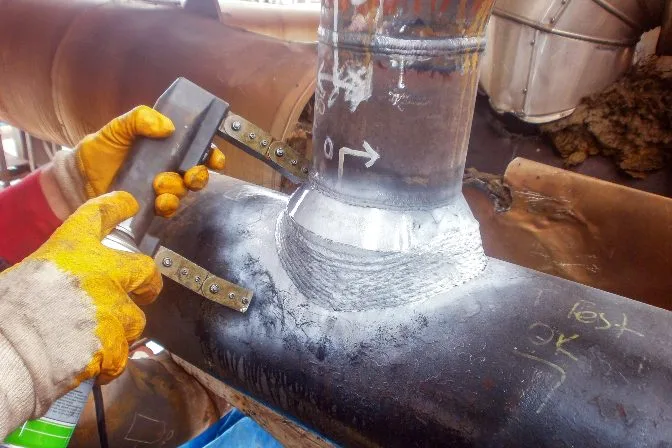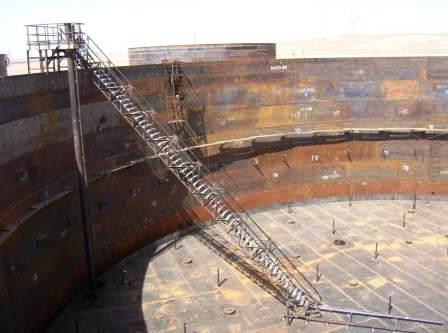The Importance of Professional Tank Welding Inspection Services
The Importance of Professional Tank Welding Inspection Services
Blog Article
An In-depth Introduction of Tank Welding Inspection Requirements and Methodologies for Improved Weld High Quality and Performance
The significance of welding inspection requirements in the production of storage tanks can not be overstated, as they serve as the foundation for making sure weld stability and functional integrity. Various evaluation methods, consisting of aesthetic analyses and advanced non-destructive testing techniques, are vital in identifying possible problems that could compromise performance.
Significance of Welding Assessment Requirements

Welding examination criteria include a series of criteria, including material specs, welding treatments, and qualifications of workers involved in the welding process. By imposing these criteria, companies can systematically recognize and correct prospective issues, consequently decreasing the likelihood of expensive repairs or tragic failures. Furthermore, strenuous evaluation techniques foster a culture of responsibility and precision, urging welders to keep high levels of workmanship.

Common Welding Evaluation Strategies


Ultrasonic Testing (UT) is one more prevalent technique, making use of high-frequency acoustic waves to identify inner problems that may not be visible externally. This method is specifically efficient for determining spaces or additions within the weld steel. Magnetic Fragment Checking (MT) is likewise widely made use of, particularly for ferromagnetic materials, as it exposes surface and near-surface flaws with the application of magnetic fields and ferrous bits.
Furthermore, Liquid Penetrant Screening (PT) finds surface-breaking problems by applying a penetrant to the weld and afterwards using a programmer to extract the penetrant. Each of these techniques adds to a comprehensive evaluation method, ensuring that welds satisfy the stringent top quality standards called for in storage tank building and construction.
Regulative Standards and Conformity
Regulatory criteria and compliance are vital elements in making certain the safety and security and dependability of bonded structures in container construction - Tank Welding check this Inspection. These standards serve to establish minimum needs for material residential or commercial properties, welding treatments, and inspection practices, thereby reducing the risk of structural failures and improving total performance
Secret companies, such as the American Culture of Mechanical Engineers (ASME) and the American Welding Culture (AWS), offer standards that are extensively taken on in the sector. Compliance with these requirements not just makes certain adherence to best methods however additionally meets legal and legal commitments, safeguarding the rate of interests of stakeholders.
Regulative bodies typically mandate adherence to specific codes, such as ASME Code Area IX for welding credentials and API 650 for bonded storage tanks. These codes detail demands for welding strategies, credentials of personnel, and screening approaches to validate weld integrity.
Regular audits and evaluations are crucial to keeping conformity, as they help recognize inconsistencies from developed criteria. Non-compliance can cause substantial fines, task hold-ups, and safety and have a peek at this website security threats. Hence, a durable understanding of regulatory criteria and a commitment to conformity are paramount in accomplishing high-grade and sturdy bonded storage tank structures.
Non-Destructive Evaluating Methods
How can the honesty of bonded frameworks be assured without creating damage? Non-destructive testing (NDT) approaches offer a durable solution, allowing assessors to examine weld high quality without compromising the product - Tank Welding Inspection. Amongst the most common NDT strategies are ultrasonic screening (UT), radiographic screening (RT), magnetic fragment screening (MT), and color penetrant testing (PT)
Ultrasonic testing employs high-frequency acoustic waves to detect internal imperfections and identify material residential properties. It gives precise measurements and is especially reliable for thick products. Radiographic testing involves passing X-rays or gamma rays with the weld, producing photos that disclose structural issues such as fractures or gaps. This technique is important for analyzing the stability of complex welds.
Magnetic bit screening is suited for ferromagnetic materials, where magnetic fields expose surface and near-surface gaps. Dye penetrant testing utilizes a liquid dye to highlight surface-breaking flaws, making it an efficient approach for non-porous materials.
Each of these NDT techniques has distinctive advantages, permitting for detailed evaluations tailored to particular materials and welding procedures. By carrying out these methods, industries can ensure the integrity and safety and security of bonded frameworks, ultimately improving general efficiency.
Enhancing Weld Top Quality With Evaluation
Effective inspection plays go to website an important duty in boosting weld quality, serving as an important checkpoint in the construction process. By recognizing prospective defects early, examinations alleviate the threat of compromised structural integrity and ensure compliance with industry standards. Employing a combination of visual evaluations, non-destructive screening (NDT) methods, and mechanical assessments, examiners can spot concerns such as porosity, fractures, and insufficient blend.
Implementing a durable evaluation protocol not just boosts the total top quality of welds however likewise fosters a culture of responsibility amongst welders and fabricators. Normal training and accreditation of assessment workers make sure that they are furnished with the essential abilities to acknowledge and address potential troubles properly. This aggressive technique lessens rework and connected costs, ultimately adding to predict performance.
Moreover, comprehensive documentation of assessment findings provides useful understandings right into recurring problems, promoting constant renovation in welding practices. By leveraging innovative modern technologies, such as automated ultrasonic testing or digital radiography, weld top quality can be improved through a lot more precise examinations. Finally, a strenuous evaluation procedure is vital in accomplishing high-grade welds, making sure safety, dependability, and longevity in container fabrication.
Conclusion
In verdict, the implementation of rigorous storage tank welding examination criteria and methods is necessary for making certain weld stability and performance. By utilizing a combination of visual assessments, non-destructive screening approaches, and adherence to regulatory standards, organizations can efficiently recognize and alleviate possible defects.
Report this page